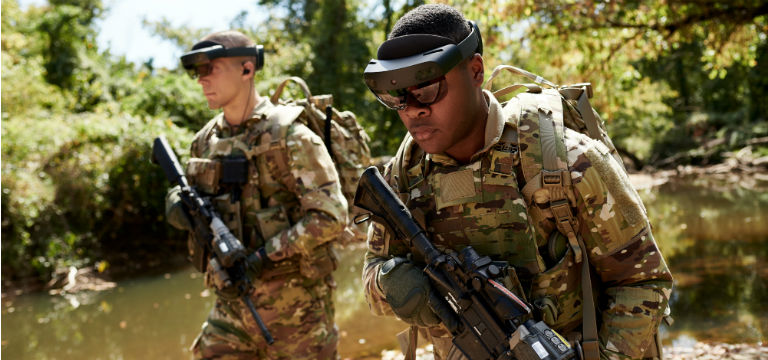IVAS and the future of defense acquisition

The Army’s Integrated Visual Augmentation System has been in the works for years, but the potentially multibillion deal could mark a paradigm shift in how the Defense Department buys and leverages technology.

Soldiers test the Integrated Visual Augmentation System (IVAS) capability set during an exercise at Fort Belvoir, VA in Fall 2019. (Army photo by Courtney Bacon)
The Army made national news when it announced a deal to buy more than 120,000 augmented reality headsets from Microsoft for $22 billion in order to enhance soldier training and situational awareness.
The Integrated Visual Augmentation System, which has been in the works for more than three years and has functions like radio communications and high-resolution night and thermal sensors, is undeniably cool. But there’s more to the potentially multibillion deal, which could mark a potential shift in how the Defense Department can and should buy new technology.
One of the biggest clues to what the future of defense acquisition looks like, at least for the next four years, could lie in President Joe Biden’s pick to oversee it, according to Tara Murphy Dougherty, the CEO of Govini, data and decision science firm.
“The biggest news in acquisition that I think still remains to be unpacked... is Mike Brown's [nomination] as undersecretary,” Murphy Dougherty said. “It clearly, in my mind, is a statement by the Biden team about how they are trying to position DOD acquisition and the focus on things like [Other Transaction Agreements] and getting out of maybe the [Federal Acquisition Regulation]-based days of old and building the bridge to the innovation community.”
That is definitely evident with IVAS, which started as a $23 million OTA and has skipped the procurement “valley of death” where promising prototypes never make it into warfighter hands.
But the lasting test of the strategy likely lies in the contract language, and whether the production contract mirrors the original OTA or if it suffers from “FAR creep,” according to Stan Soloway, the former deputy undersecretary of defense for acquisition reform.
Soloway, who runs the consulting firm Celero Strategies, told FCW the production deal is “potentially fairly significant, but what we don’t know is how precedential it’s going to be.”
“If you look at the transitions to production that are taking place, very often the production contract looks more and more like a traditional FAR contract,” Soloway said, “in other words, even though the government has the authority to use the same OTs [we] see they are most often actually not taking advantage of it.”
The result could lead to non-traditional companies, which the Defense Department is trying to attract, exiting deals once they move to production.
“The one big question is: is the production contract a continuation of those commercial terms and conditions that were in the original OTA? If the answer is yes, that could set the stage for a lot more successful transitions to production,” Soloway said. “If the answer is no, we remain stuck in this, yes OTAs can help expedite the process, they can help bring new capabilities into the process, but it's not clear that they're going to be as successful in expanding the industrial base, which is one of the purposes.”
Jerry McGinn, former principal deputy director at the Defense Department‘s office of manufacturing and industrial base policy, told FCW that other transaction agreements can’t be made into "an end in themselves," but should be used to fuel innovation.
"You want to use those kind of vehicles to bring in non-traditional [companies] to bring in new commercial tech, test drive it to find out if it works. And then you want to transition it to you know to programs of record -- and those aren't OTs. So it's got to be part of the toolbox,” said McGinn, who is now the executive director for the government contracting initiative at George Mason University’s School of Business.
"You can't make them an end in themselves."
But with IVAS’ success and the steady increased use of other transaction agreements, the oversight isn’t far behind.
"I worry about [the Government Accountability Office], the inspectors general, and I worry about Congress,” McGinn said -- though he stressed that there is a legitimate need to protect taxpayer dollars and prevent waste, fraud and abuse.
But just as Congress granted the new acquisition authorities to accelerate DOD’s adoption of emerging technology, the legislative body and other watchdog entities may need reform as well when it comes to their oversight duties.
“They have oversight functions that are completely appropriate,” McGinn said, “but the challenge is how they evaluate programs -- cost, schedule, and performance and other oversight functions. Those were all set up to deal with the regular acquisition system and in the 1950s.”
McGinn said the way Congress and other watchdog organizations conduct their oversight duties must change to match new, rapidly changing technologies.
“These functions are incredibly important and they need to because you got to protect taxpayer dollars,” McGinn said, “but we have to have a paradigm shift in acquisition governance structures as well as the acquisition approaches in order to be ultimately successful.”
NEXT STORY: Could 2022 see the end of OCO?



